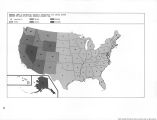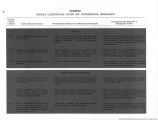| OCR Text |
Show CHAPTER FIVE Timber Resources THE FEDERAL GOVERNMENT has a dominant position in the Nation's timber economy. Just before and after the beginning of the 20th century, vast areas of timberland were reserved from disposal under the public land laws for the express purpose of guaranteeing that the country would have a continuous supply of timber to meet its future needs. These reserves were later supplemented by additional timberlands acquired primarily in the eastern states. As a result, the Federal Government now owns some 20 percent of all of the country's commercial forest land, nearly 40 percent of its supply of merchantable timber and over 60 percent of its softwood sawtimber. The degree of potential Federal control over the supply of timber is greater than over that of any other commodity presently produced from public lands. In part because of the success of management programs on privately owned timberlands, in part because of the conservative manner in which Federal timber has been permitted to enter the economy in the past, and in part because of continuing changes in the wood needs of the country, the Nation's ability to meet its long-range future wood needs is promising, as long as the timber grown on both public and private lands is made available for harvesting. This is in sharp contrast to judgments often made as recently as the 1930's and 1940's. At the present time, the wood needs of the United States are increasing rapidly. Also, exports of logs, particularly to Japan, increased dramatically during the 1960's. Forest lands, both public and private, are being withdrawn from timber harvesting and set aside for other purposes. Although private timberlands met the major burden of our wood requirements during the first half of this century, the pressure is now on public lands to supply much of the country's wood needs in the near future. Despite this tremendous responsibility of the Federal Government, the statutes applicable to most of the Federal forest lands provide at best inadequate policy guidelines directing how these public lands are to be managed or timber made available to meet our needs. Regardless of the reasons why the Federal Government became, by far, the country's leading owner and manager of forest lands and timber, and regardless of the relevancy of these reasons to today's conditions, the facts are: -Federally owned timber is vital to the wood economy of the country; -Federally owned timber is vital to the economies of many communities; -Federal policies with respect to the sale of this timber can result in the life or death of firms that use it; -The Federal Government's dominance as a supplier of timber will continue in the future. Although this chapter sets forth the Commission's recommendations concerning timber as a commodity of the public lands, the recommendations were arrived at, as were all our recommendations, only after giving full consideration to all other uses that can and must be made of the forests. This is emphasized because we recognize that the potential for conflicts among competing uses is particularly high on public forest lands. While wood harvesting, watershed protection, and grazing were always primary purposes of forests on public lands, recreation use, including wilderness areas, has assumed a growing importance in recent years. The availability of a continuing timber supply depends in part on the extent to which public forest lands are allocated to meet the demands for other uses. Despite this and the fact that, of all the various classes of public lands, forest lands generally are capable of producing the most combinations of commodities and, in many cases, the highest values, there are no statutory guidelines to indicate how the various uses are to be balanced. The diversity and intensity of use dictates that great care be taken on forest lands to assure that environmental values are not lost through poor forestry practices. This is especially important on 91 |







































































































































































































































































































































































